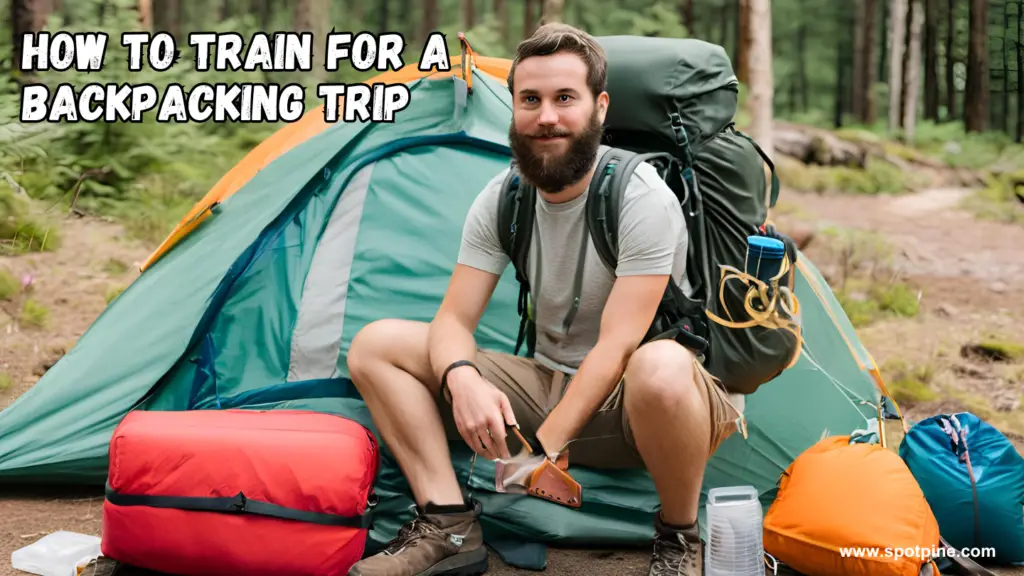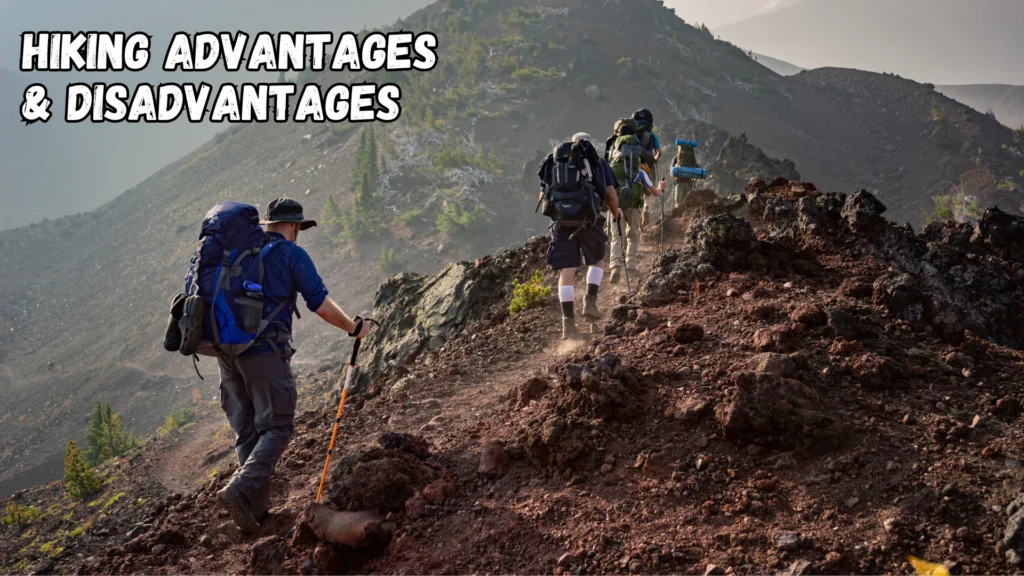To train for a backpacking trip, focus on building endurance and strength through hiking, cardio, and resistance training. Incorporate uphill hikes, long walks, and weight-bearing exercises to prepare your body for the demands of backpacking.
Strengthen your core, legs, and back to handle the extra weight. Additionally, practice carrying a loaded backpack to get used to the weight and ensure your gear fits comfortably. Furthermore, work on improving your balance, agility, and flexibility to navigate uneven terrains.
In addition, don’t forget to gradually increase your mileage and include elevation gain in your training to mimic real backpacking conditions. Once you are physically prepared, find time to mentally prepare by visualizing the challenges you may face and planning for various scenarios, ensuring a successful and enjoyable trip.
Choose The Right Gear
When preparing for a backpacking trip, choosing the right gear is crucial for a successful and enjoyable experience.
Selecting a backpack
Selecting a backpack that fits well and is comfortable to carry is essential. Ensure it has enough capacity for your trip essentials.
Choosing A Sleeping Bag
Choose a sleeping bag that suits the climate you will be hiking in. Consider its weight, insulation, and compactness for easy packing.
Packing A Tent
Packing a tent that is lightweight yet durable is important. Make sure it provides adequate shelter and protection from the elements.
Remember, your gear can make or break your backpacking adventure, so choose wisely!
Physical Preparation
When preparing for a backpacking trip, physical training is crucial. The following areas require focus to optimize your readiness.
Cardiovascular Conditioning
Running, cycling or swimming enhances heart health and improves endurance.
Strength Training
Body-weight exercises, weightlifting, and resistance bands build muscle strength.
Endurance Training
Include long hikes, intervals, and hill climbs to boost stamina.
Practicing Pack Weight Management
Prepare for your backpacking adventure by practising pack weight management. By gradually increasing the weight in your pack during training, you can strengthen your muscles and build endurance. This will help ensure that you are prepared for the physical demands of your trip.
Starting With Lighter Loads
If you’re new to backpacking or looking to train for an upcoming trip, one of the first aspects to consider is pack weight management. Carrying a heavy backpack can quickly wear you down, affecting your endurance and overall enjoyment of the trip. To build strength and stamina, it’s essential to start with lighter loads as you begin your training journey. Consider these tips to start with lighter loads:
- Begin by packing your backpack with only the essentials.
- Evaluate each item and ask yourself if it’s absolutely necessary.
- Opt for gear that is lightweight and compact to minimize overall weight.
- Research and invest in ultralight backpacking gear options to reduce the load on your back.
By starting with lighter loads, you allow yourself to gradually build your endurance and prepare for the challenges of backpacking. Remember, less weight equals more comfort and enjoyment on the trails.
Adding Weight Gradually
Once you feel comfortable with lighter loads and have built some endurance, it’s time to start adding weight gradually. This step is crucial as it helps your body adjust to the increased load that you’ll be carrying during your backpacking trip. Follow these guidelines when adding weight gradually:
- Use sandbags or weighted vests to incrementally increase the load in your backpack.
- Start by adding 5-10 pounds to your pack, depending on your fitness level.
- Gradually increase the weight every week or two, giving your body time to adapt.
- Focus on maintaining proper form and technique as you train with heavier loads.
- Listen to your body and make adjustments if you experience any pain or discomfort.
By adding weight gradually, you allow your muscles to strengthen over time, reducing the risk of injury and ensuring that you’re fully prepared for the demands of your backpacking adventure.
Simulating Real Conditions
To truly prepare for a backpacking trip, it’s important to simulate real conditions as much as possible during your training. This means replicating the terrain, weather, and environmental elements that you’ll likely encounter during your journey. Consider these steps for simulating real conditions:
- Hike on similar terrains, such as hills, mountains, or trails with varied elevations.
- Train with your fully loaded backpack to mimic the weight distribution and balance.
- Practice hiking in different weather conditions, such as rain, heat, or wind.
- Account for the altitude changes if your backpacking trip involves high-altitude locations.
- Consider camping overnight to experience setting up a tent and sleeping in outdoor conditions.
By simulating real conditions during your training, you’ll be better prepared mentally and physically for the challenges that come with backpacking. It will also give you an opportunity to test your gear, make adjustments, and ensure that you are well-prepared for your upcoming adventure.
Mastering Navigation Skills
When preparing for a backpacking trip, mastering navigation skills is crucial for a safe and enjoyable adventure. Understanding maps and compasses, learning to use GPS devices, and practising route planning are essential for a successful backpacking experience.
Understanding Maps And Compasses
An important aspect of navigation training is understanding how to read maps and use compasses effectively. Maps provide valuable information about the terrain, elevation, and landmarks, helping backpackers visualize the route ahead. Compasses, on the other hand, act as reliable tools for determining direction and orientation in the wilderness.
Learning To Use Gps Devices
GPS devices have become indispensable tools for modern backpackers. These devices offer accurate positioning, mapping, and tracking features. Learning how to use GPS devices ensures that backpackers can navigate unfamiliar trails with confidence, and emergency services can be contacted if necessary.
Practicing Route Planning
Route planning is a critical skill for backpackers. It involves assessing trail difficulty, estimating travel times, and identifying potential hazards. Practising route planning allows backpackers to anticipate challenges and make informed decisions about their journey, contributing to a safe and enjoyable backpacking experience.
Developing Campsite Skills
Developing Campsite Skills is an essential aspect of backpacking training, as it equips you with the necessary knowledge and abilities to thrive in the great outdoors. Mastering skills such as setting up a tent or hammock, building a fire, and cooking camp meals can significantly enhance your wilderness experience and ensure a safe and enjoyable trip.
Setting Up Tent And Hammock
Setting up a tent or hammock is a fundamental skill for any backpacker. When pitching a tent, it’s crucial to find a flat, well-drained spot. Begin by laying out the tent and staking down the corners. Assemble the tent poles and secure them, ensuring the rain fly is positioned correctly. Tying a secure and tight knot is crucial when setting up a hammock. Proper tension and angle provide comfort and stability.
Building A Fire
Familiarizing yourself with fire-building techniques is vital for warmth, cooking, and warding off wild animals. Gather dry twigs, leaves, and kindling to start a fire. Arrange the larger logs in a teepee or log cabin formation. Use matches or a lighter to ignite the fire. Keep a source of water nearby and ensure the fire is fully extinguished before leaving the campsite.
Cooking Camp Meals
Preparing meals while backpacking requires planning and knowledge of proper camp cooking methods. Utilize lightweight cooking equipment and choose meals that are quick and easy to prepare. Opt for dehydrated or freeze-dried meals to minimize weight. Consider the use of a backpacking stove for efficient cooking. Practice Leave No Trace principles when disposing of food waste and cleaning cooking utensils to minimize impact on the environment.
Mental Preparation
Mental preparation plays a crucial role in training for a backpacking trip. Focusing on building resilience, staying positive, and developing a strong mindset can help you overcome challenges and fully enjoy your adventure in the wilderness.
Managing Stress And Anxiety
The key to a successful backpacking trip lies not only in physical fitness but also in mental preparation. Stress and anxiety can be common when embarking on a challenging adventure like backpacking, but with the right strategies in place, you can manage them effectively.
Building Mental Resilience
Building mental resilience is crucial for overcoming any obstacles that may arise during your backpacking trip. It involves developing the ability to bounce back from setbacks and to stay motivated when faced with challenges.

Practicing Mindfulness
Mindfulness is a powerful practice that can greatly enhance your backpacking experience. By staying present in the moment and paying attention to your thoughts, feelings, and surroundings, you can fully immerse yourself in the journey.
- Take regular breaks: Rest is essential for maintaining mental clarity and preventing burnout. Schedule short breaks during your backpacking trips to recharge.
- Meditate: Dedicate a few minutes each day to meditation. It can help you cultivate focus and reduce stress.
- Practice deep breathing: Deep breathing exercises can help calm your mind and reduce anxiety. Take slow, deep breaths whenever you feel overwhelmed.
- Affirmations: Use positive affirmations to boost your confidence and maintain a positive mindset. Repeat phrases like “I am strong and capable” whenever self-doubt creeps in.
In summary, mental preparation is crucial for a successful backpacking trip. By managing stress and anxiety, building mental resilience, and practicing mindfulness, you can fully embrace the challenges and wonders of the great outdoors. Remember to take care of your mental well-being and enjoy every step of your journey!
Learning Wilderness First Aid
When preparing for a backpacking trip, it is essential to equip yourself with the knowledge of wilderness first aid. Being miles away from civilization means that you must be self-reliant in handling any injuries or emergencies that may occur. This article will guide you through the basic first aid techniques, treating common backpacking injuries, and dealing with emergencies.
Basic First Aid Techniques
Having basic first aid skills is crucial for any backpacker. Here are some essential techniques you should learn:
- Create a triangle bandage by folding a piece of fabric into a triangular shape. This can be used for splinting, supporting injured limbs, or creating slings.
- Master the art of cleaning and dressing wounds. Use clean water or saline solution to flush out dirt and debris before applying a sterile dressing or bandage.
- Understand the importance of handling fractures. Learn how to immobilize injured limbs using splints or improvised materials such as sturdy sticks or trekking poles.
- Practice performing CPR on a mannequin and familiarize yourself with the proper technique, including chest compressions and rescue breaths.
Treating Common Backpacking Injuries
During your backpacking trip, it is not uncommon to experience certain injuries. Knowing how to handle these common issues will ensure your safety:
Sprains and Strains
If you twist your ankle or strain your muscle, follow the R.I.C.E. method:
- Rest: Avoid putting weight on the injured limb.
- Ice: Apply a cold pack or ice wrapped in a cloth to reduce swelling.
- Compression: Use an elastic bandage to wrap the injured area firmly but not too tight.
- Elevation: Raise the injured limb above heart level to minimize swelling.
Blisters
Blisters can be painful and affect your ability to continue hiking. Here’s how to treat them:
- Clean the area with antiseptic wipes.
- Apply a blister pad or moleskin directly onto the blister to reduce friction.
- Cover the pad with adhesive tape to secure it in place.
Dealing With Emergencies
While backpacking, emergencies may arise that require immediate action. Here are a few critical situations and how to handle them:
Snake Bites
If someone is bitten by a snake:
- Ensure the bitten individual stays calm and still to slow down the spread of venom.
- Keep the affected limb below the level of the heart to minimize venom circulation.
- Seek medical help as soon as possible while immobilizing the bitten limb.
Hypothermia
If someone shows signs of hypothermia:
- Remove wet clothing: Replace it with dry layers or blankets.
- Warm the person: Apply gentle heat using hot water bottles or blankets.
- Provide warm fluids: Offer warm beverages to help raise the core body temperature.
- Seek immediate medical attention: Severe hypothermia requires professional help.
By mastering these wilderness first aid techniques, you will be well-prepared to handle common injuries and emergencies during your backpacking trip. Remember to always carry a well-stocked first aid kit and inform someone of your itinerary before venturing into the wilderness.

Acclimatizing To Altitude
Altitude sickness occurs at high elevations due to low oxygen levels. Symptoms include headache and nausea.
- Gradually increase altitude to allow your body to adapt.
- Descend if symptoms worsen to prevent severe altitude sickness.
- Drink plenty of water to stay hydrated at high altitudes.
- Eat foods rich in carbohydrates and electrolytes to maintain energy levels.
FAQs:
How Long Does It Take To Train For A Backpacking Trip?
To train for a backpacking trip, it usually takes 4 to 6 weeks of physical conditioning.
How Do I Get Fit For A Backpacking Trip?
Prepare for backpacking by incorporating cardio, strength, and flexibility exercises into your routine. Include hiking, running, cycling, and core workouts. Gradually increase the intensity to build endurance. Don’t forget to practice carrying a loaded backpack to simulate the trip’s demands.
How Do You Strength Train For Backpacking?
To strength train for backpacking, focus on exercises that build endurance and strength for your legs, core, and back. Incorporate squats, lunges, deadlifts, and planks into your routine. Also, include cardio activities like hiking, cycling, and stair climbing to improve stamina.
How Do You Train For A 40-Mile Backpacking Trip?
To train for a 40-mile backpacking trip, gradually increase your walking distance each week. Carry a weighted backpack during training to build endurance. Practice hiking on different terrains and inclines to prepare for the trip’s challenges. Stay hydrated and maintain a balanced diet for optimum performance.
Conclusion
To sum it up, training for a backpacking trip is crucial to ensure a successful and enjoyable experience in the great outdoors. By focusing on cardiovascular exercises, strength training, and practicing with a backpack, you can improve your endurance and prepare your body for the physical demands of backpacking.
Additionally, don’t forget to invest in good hiking gear and educate yourself about the trail conditions and weather. Remember, proper preparation is the key to a safe and rewarding backpacking adventure. Happy trails!



